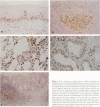Abstract
A monoclonal antibody (Ki-S1) has been raised that reacts with the nuclei of proliferating cells. The antigen recognized is resistant to formalin fixation and can be detected in frozen tissues as well as in routinely processed specimens. In immunohistochemistry, nuclear staining can be seen in those tissues and cellular compartments known to be actively proliferating. Peripheral blood lymphocytes are negative but show a strong increase in antigen expression after mitogen stimulation. Flow cytometric determination of DNA content and antigen expression revealed negativity of G0 cells and positivity of G1 to G2/M cells. A cytoplasmic co-reactivity, not associated with proliferation, was confined to Langerhans islands of the pancreas. The nuclear localized antigen has a molecular mass of 160 kd and therefore seems to be different from all other known immunohistochemical markers of proliferating cells. We conclude that the monoclonal antibody Ki-S1 might provide a useful tool for studying cell proliferation in situ under normal and pathological circumstances.
Full text
PDF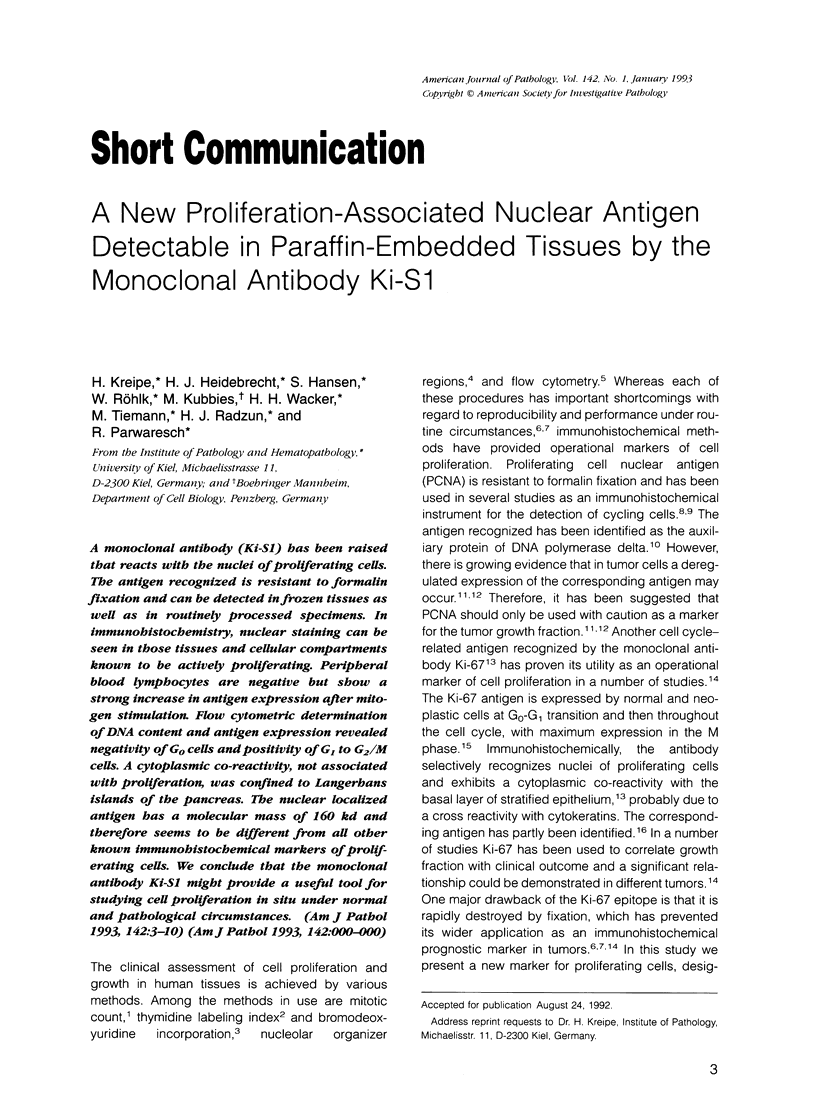
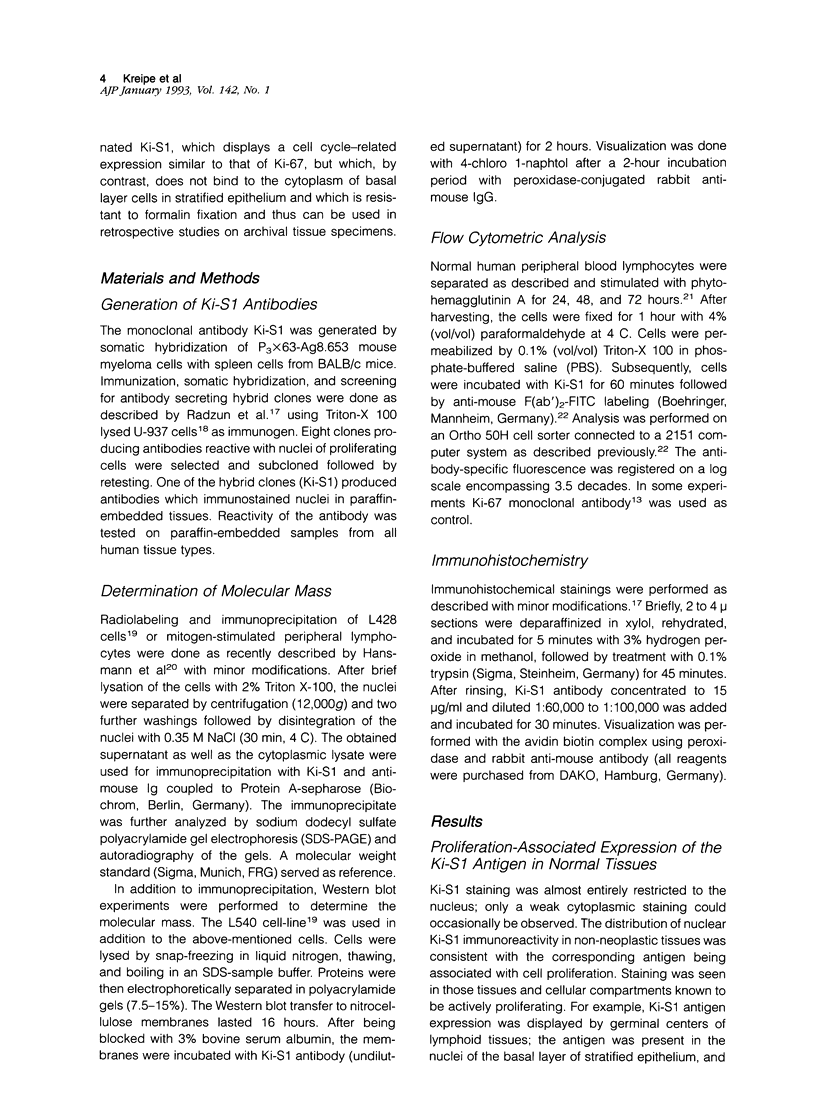
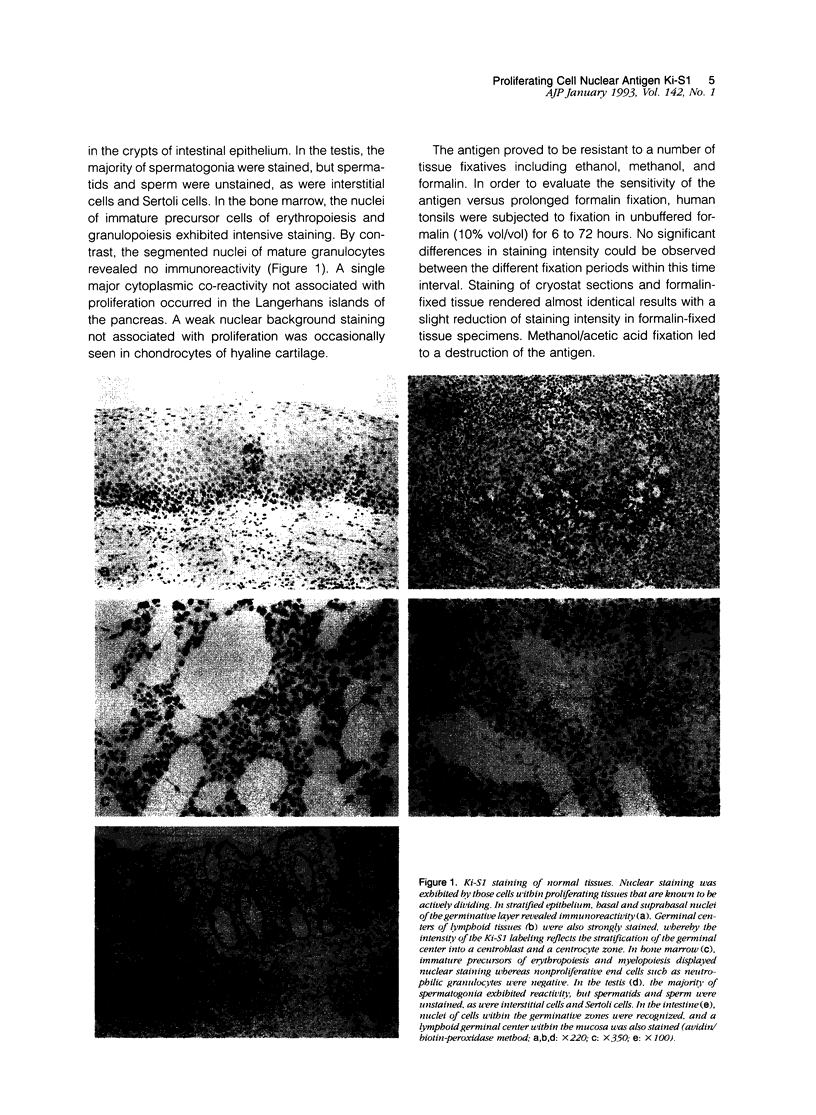
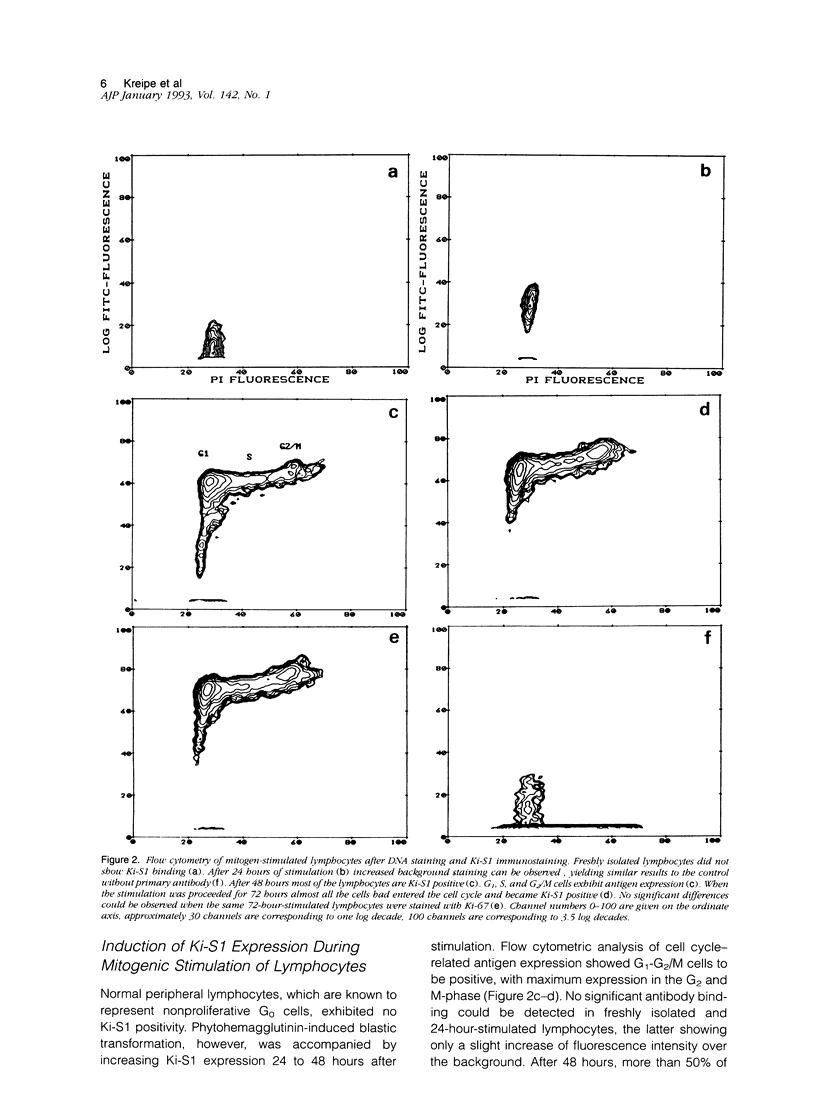
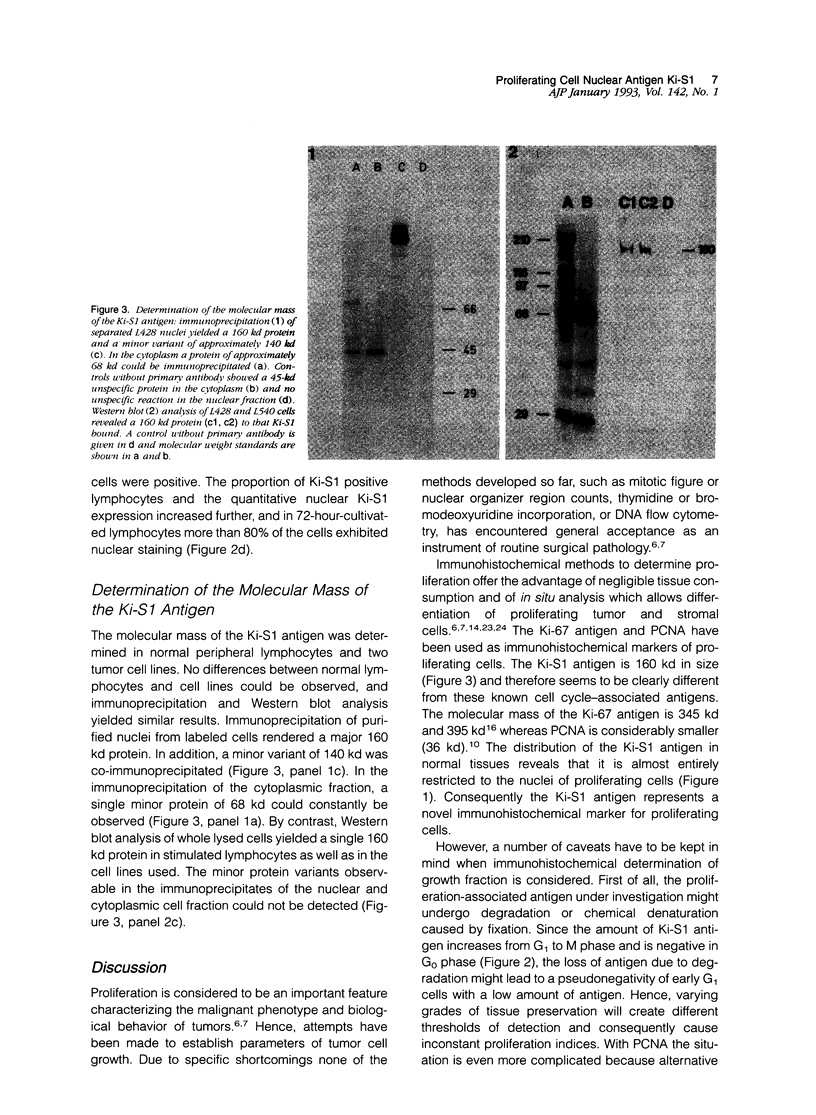
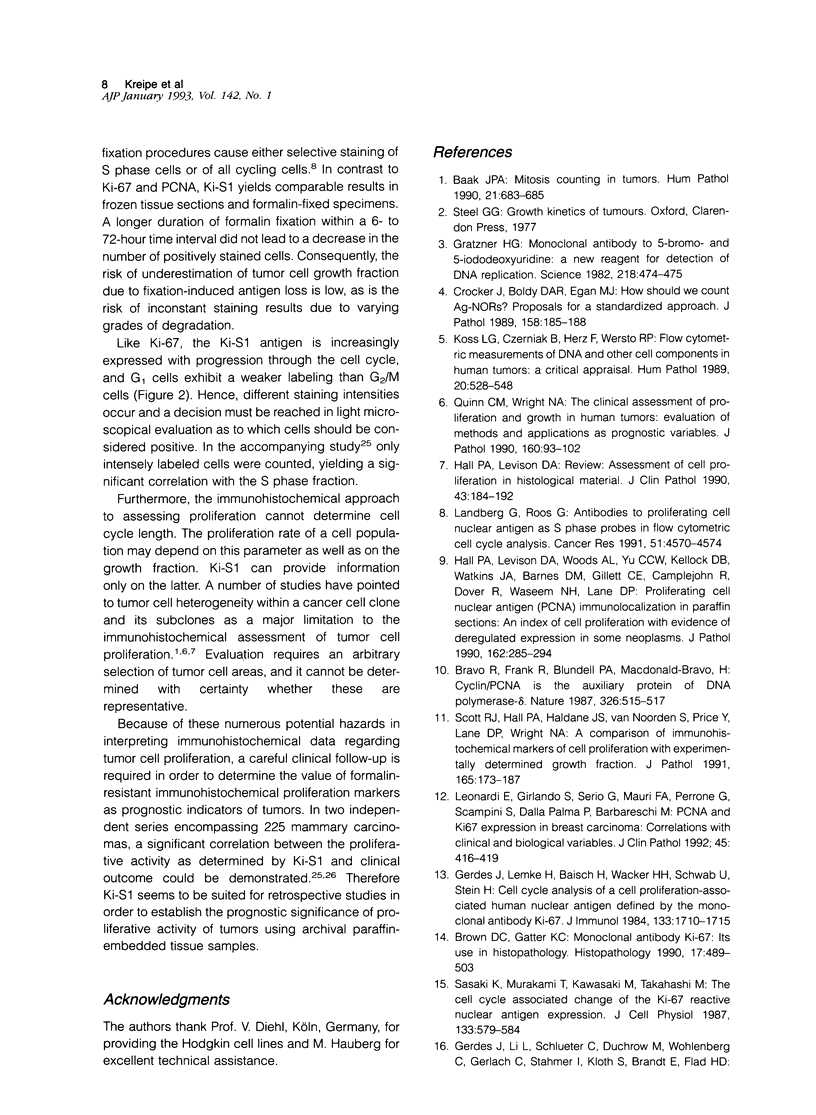
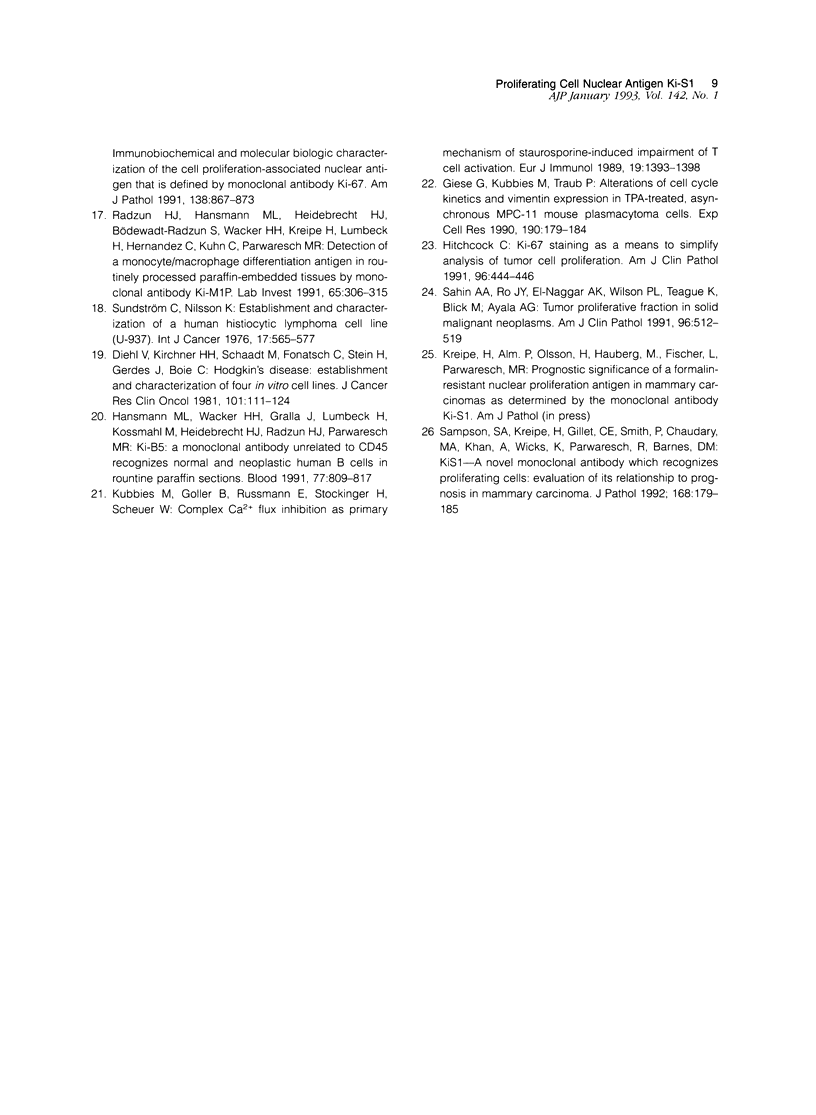
Images in this article
Selected References
These references are in PubMed. This may not be the complete list of references from this article.
- Baak J. P. Mitosis counting in tumors. Hum Pathol. 1990 Jul;21(7):683–685. doi: 10.1016/0046-8177(90)90026-2. [DOI] [PubMed] [Google Scholar]
- Bravo R., Frank R., Blundell P. A., Macdonald-Bravo H. Cyclin/PCNA is the auxiliary protein of DNA polymerase-delta. Nature. 1987 Apr 2;326(6112):515–517. doi: 10.1038/326515a0. [DOI] [PubMed] [Google Scholar]
- Brown D. C., Gatter K. C. Monoclonal antibody Ki-67: its use in histopathology. Histopathology. 1990 Dec;17(6):489–503. doi: 10.1111/j.1365-2559.1990.tb00788.x. [DOI] [PubMed] [Google Scholar]
- Crocker J., Boldy D. A., Egan M. J. How should we count AgNORS? Proposals for a standardized approach. J Pathol. 1989 Jul;158(3):185–188. doi: 10.1002/path.1711580303. [DOI] [PubMed] [Google Scholar]
- Diehl V., Kirchner H. H., Schaadt M., Fonatsch C., Stein H., Gerdes J., Boie C. Hodgkin's disease: establishment and characterization of four in vitro cell lies. J Cancer Res Clin Oncol. 1981;101(1):111–124. doi: 10.1007/BF00405072. [DOI] [PubMed] [Google Scholar]
- Gerdes J., Lemke H., Baisch H., Wacker H. H., Schwab U., Stein H. Cell cycle analysis of a cell proliferation-associated human nuclear antigen defined by the monoclonal antibody Ki-67. J Immunol. 1984 Oct;133(4):1710–1715. [PubMed] [Google Scholar]
- Giese G., Kubbies M., Traub P. Alterations of cell cycle kinetics and vimentin expression in TPA-treated, asynchronous MPC-11 mouse plasmacytoma cells. Exp Cell Res. 1990 Oct;190(2):179–184. doi: 10.1016/0014-4827(90)90183-b. [DOI] [PubMed] [Google Scholar]
- Gratzner H. G. Monoclonal antibody to 5-bromo- and 5-iododeoxyuridine: A new reagent for detection of DNA replication. Science. 1982 Oct 29;218(4571):474–475. doi: 10.1126/science.7123245. [DOI] [PubMed] [Google Scholar]
- Hall P. A., Levison D. A. Review: assessment of cell proliferation in histological material. J Clin Pathol. 1990 Mar;43(3):184–192. doi: 10.1136/jcp.43.3.184. [DOI] [PMC free article] [PubMed] [Google Scholar]
- Hall P. A., Levison D. A., Woods A. L., Yu C. C., Kellock D. B., Watkins J. A., Barnes D. M., Gillett C. E., Camplejohn R., Dover R. Proliferating cell nuclear antigen (PCNA) immunolocalization in paraffin sections: an index of cell proliferation with evidence of deregulated expression in some neoplasms. J Pathol. 1990 Dec;162(4):285–294. doi: 10.1002/path.1711620403. [DOI] [PubMed] [Google Scholar]
- Hansmann M. L., Wacker H. H., Gralla J., Lumbeck H., Kossmahl M., Heidebrecht H. J., Radzun H. J., Parwaresch M. R. Ki-B5: a monoclonal antibody unrelated to CD45 recognizes normal and neoplastic human B cells in routine paraffin sections. Blood. 1991 Feb 15;77(4):809–817. [PubMed] [Google Scholar]
- Hitchcock C. L. Ki-67 staining as a means to simplify analysis of tumor cell proliferation. Am J Clin Pathol. 1991 Oct;96(4):444–446. doi: 10.1093/ajcp/96.4.444. [DOI] [PubMed] [Google Scholar]
- Koss L. G., Czerniak B., Herz F., Wersto R. P. Flow cytometric measurements of DNA and other cell components in human tumors: a critical appraisal. Hum Pathol. 1989 Jun;20(6):528–548. doi: 10.1016/0046-8177(89)90244-x. [DOI] [PubMed] [Google Scholar]
- Kubbies M., Goller B., Russmann E., Stockinger H., Scheuer W. Complex Ca2+ flux inhibition as primary mechanism of staurosporine-induced impairment of T cell activation. Eur J Immunol. 1989 Aug;19(8):1393–1398. doi: 10.1002/eji.1830190807. [DOI] [PubMed] [Google Scholar]
- Landberg G., Roos G. Antibodies to proliferating cell nuclear antigen as S-phase probes in flow cytometric cell cycle analysis. Cancer Res. 1991 Sep 1;51(17):4570–4574. [PubMed] [Google Scholar]
- Leonardi E., Girlando S., Serio G., Mauri F. A., Perrone G., Scampini S., Dalla Palma P., Barbareschi M. PCNA and Ki67 expression in breast carcinoma: correlations with clinical and biological variables. J Clin Pathol. 1992 May;45(5):416–419. doi: 10.1136/jcp.45.5.416. [DOI] [PMC free article] [PubMed] [Google Scholar]
- Quinn C. M., Wright N. A. The clinical assessment of proliferation and growth in human tumours: evaluation of methods and applications as prognostic variables. J Pathol. 1990 Feb;160(2):93–102. doi: 10.1002/path.1711600202. [DOI] [PubMed] [Google Scholar]
- Radzun H. J., Hansmann M. L., Heidebrecht H. J., Bödewadt-Radzun S., Wacker H. H., Kreipe H., Lumbeck H., Hernandez C., Kuhn C., Parwaresch M. R. Detection of a monocyte/macrophage differentiation antigen in routinely processed paraffin-embedded tissues by monoclonal antibody Ki-M1P. Lab Invest. 1991 Sep;65(3):306–315. [PubMed] [Google Scholar]
- Sahin A. A., Ro J. Y., el-Naggar A. K., Wilson P. L., Teague K., Blick M., Ayala A. G. Tumor proliferative fraction in solid malignant neoplasms. A comparative study of Ki-67 immunostaining and flow cytometric determinations. Am J Clin Pathol. 1991 Oct;96(4):512–519. doi: 10.1093/ajcp/96.4.512. [DOI] [PubMed] [Google Scholar]
- Sampson S. A., Kreipe H., Gillett C. E., Smith P., Chaudary M. A., Khan A., Wicks K., Parwaresch R., Barnes D. M. KiS1--a novel monoclonal antibody which recognizes proliferating cells: evaluation of its relationship to prognosis in mammary carcinoma. J Pathol. 1992 Oct;168(2):179–185. doi: 10.1002/path.1711680205. [DOI] [PubMed] [Google Scholar]
- Sasaki K., Murakami T., Kawasaki M., Takahashi M. The cell cycle associated change of the Ki-67 reactive nuclear antigen expression. J Cell Physiol. 1987 Dec;133(3):579–584. doi: 10.1002/jcp.1041330321. [DOI] [PubMed] [Google Scholar]
- Scott R. J., Hall P. A., Haldane J. S., van Noorden S., Price Y., Lane D. P., Wright N. A. A comparison of immunohistochemical markers of cell proliferation with experimentally determined growth fraction. J Pathol. 1991 Oct;165(2):173–178. doi: 10.1002/path.1711650213. [DOI] [PubMed] [Google Scholar]
- Sundström C., Nilsson K. Establishment and characterization of a human histiocytic lymphoma cell line (U-937). Int J Cancer. 1976 May 15;17(5):565–577. doi: 10.1002/ijc.2910170504. [DOI] [PubMed] [Google Scholar]



